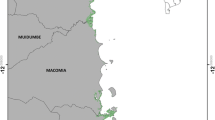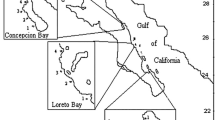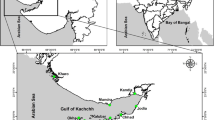Abstract
The structure and regeneration patterns of the peri-urban mangrove vegetation of Mombasa at Tudor creek were studied along belt transects at two forest sites of Kombeni and Tsalu. Based on the species importance values, the dominant mangrove species were Rhizophora mucronata Lam. (Rhizophoraceae) and Avicennia marina (Forssk.) Vierh. (Avicenniaceae). Lumnitzera racemosa Willd., reported in an earlier floristic survey, was not encountered. Tree density varied from 1,264 trees ha–1 at Kombeni to 1,301 trees ha–1 at Tsalu and mean tree height was higher at the former site compared to the latter. The size-class structure at both localities showed the numerical dominance of small trees over larger trees. The spatial distribution pattern of adults and juveniles varied greatly between sites and showed a close to uniform pattern (Morisita’s Index I δ ≪ 1) for adult trees, but a tendency to clustered distribution (I δ ≫ 1) for juveniles. The present paper shows that unmanaged but exploited peri-urban mangroves are structurally stressed, having enlarged canopy gaps that are characterised by spatial and temporal site heterogeneity that influences regeneration, implying longer periods for canopy closure. Diversifying uses of mangrove products and establishing reserves as no cut zones with regulated harvesting will minimise canopy gap sizes, and promote conservation practices. The proposed management strategy shall boost the ecosystem resilience to both anthropogenic and natural stressors expected in the peri-urban setting in the long run.




Similar content being viewed by others
References
Abuodha PAW, Kairo JG (2001) Human-induced stresses on mangrove swamps along the Kenyan coast. Hydrobiologia 458:255–265
Allen JA, Ewel KC, Jack J (2001) Patterns of natural and anthropogenic disturbance of the mangroves on the Pacific island of Kosrae. Wetlands Ecol Manage 9:279–289
Alongi DM (2002) Present state and future of the world’s mangrove forests. Environ Conserv 29(3):331–349
Alongi DM, de Carvalho NA (2008) The effect of small-scale logging on stand characteristics and soil biogeochemistry in mangrove forests of Timor Leste. For Ecol Manage 255:1359–1366
Barbier EB (2000) Valuing the environment as input: review of applications to mangrove-fishery linkages. Ecol Econ 35:47–61
Benfield SL, Guzman HM, Mair JM (2005) Temporal mangrove dynamics in relation to coastal development in Pacific Panama. J Environ Manage 76:263–276
Boonsong K, Plyatiratitivorakul S, Patanapompalboon P (2003) Potential use of mangrove plantation as constructed wetland for municipal wastewater treatment. Water Sci Technol 48(5):257–266
Bosire JO, Dahdouh-Guebas F, Kairo JG, Koedam N (2003) Colonization of non-planted mangrove species into restored mangrove stands in Gazi bay, Kenya. Aquat Bot 76:267–279
Bosire JO, Kairo JG, Kazungu J, Koedam N, Dahdouh-Guebas F (2005) Predation on propagules regulates regeneration in a high-density reforested mangrove plantation. Mar Ecol Prog Ser 299:149–155
Brokaw N, Thompson J (2000) The H for DBH. For Ecol Manage 129:89–91
Bundotich G (2007) Structural inventory of mangrove forests in Ngomeni, Kenya. MSc Thesis, Egerton University
Cannicci S, Burrows D, Fratini S, Lee SY, Smith TJ III, Offenberg J, Dahdouh-Guebas F (2008) Faunistic impact on vegetation structure and ecosystem function in mangrove forests: a review. Aquat Bot 89(2):186–200
Chong PW (1988) Proposed integrated forest management planning and utilization of mangrove resources in the Terraba-Sierpe Reserve, Costa Rica, TCP. FAO, Rome
Cintrón C, Schaeffer-Novelli Y (1984) Methods for studying mangrove structure. In: Snadaker SC, Snaedaker JG (eds) The mangrove ecosystem research methods. UNESCO, Paris, France, pp 91–113
Clarke PJ (2004) Effects of experimental canopy gaps on mangrove recruitment: lack of habitats partitioning may explain stand dominance. J Ecol 92:203–213
Clarke PJ, Kerrigan RA (2000) Do forest gaps influence the population structure and species composition of mangrove stands in Northern Australia? Biotropica 32(4a):642–652
Clarke PJ, Kerrigan RA (2002) The effects of seed predators on the recruitment of mangroves. J Ecol 90(4):728–736
Clutter JL, Fortson JC, Pienaar LV, Brister GH, Bailey RL (1983) Timber management: a quantitative approach. Wiley and Sons, 333 pp
Dahdouh-Guebas F, Koedam N (2006a) Empirical estimate of the reliability of the use of the Point-Centred Quarter Method (PCQM): solutions to ambiguous field situations and description of the PCQM protocol. For Ecol Manage 228:1–18
Dahdouh-Guebas F, Koedam N (2006b) Coastal vegetation and the Asian tsunami. Science 311:37–38
Dahdouh-Guebas F, Koedam N (2008) Long-term retrospection on mangrove development using transdisciplinary approaches: a review. Aquat Bot. doi:10.1016/j.aquabot.2008.03.012
Dahdouh-Guebas F, Mathenge C, Kairo JG, Koedam N (2000) Utilisation of mangrove wood products around Mida creek (Kenya) among subsistence and commercial users. Econ Bot 54(4):513–527
Dahdouh-Guebas F, Van Pottelbergh I, Kairo JG, Cannicci S, Koedam N (2004) Human-impacted mangroves in Gazi (Kenya): predicting future vegetation based on retrospective remote sensing, social surveys, and distribution of trees. Mar Ecol Prog Ser 272:77–92
Dahdouh-Guebas F, Hettiarachchi S, Lo Seen D, Batelaan O, Sooriyarachchi S, Jayatissa LP, Koedam N (2005) Transitions in ancient inland freshwater resource management in Sri Lanka affect biota and human populations in and around coastal lagoons. Curr Biol 15:579–586
Doute RN, Ochanda N, Epp H (1981) A forest inventory using remote sensing techniques. KREMU, Technological Report, Series No. 10. Rangeland Monitoring Unit, Nairobi, Kenya
Duke N (2001) Gap creation and regenerative processes driving diversity and structure of mangrove ecosystems. Wetlands Ecol Manage 9:257–269
Duke NC, Meynecke J-O, Dittmann S, Ellison AM, Anger K, Berger U, Cannicci S, Diele K, Ewel KC, Field CD, Koedam N, Lee SY, Marchand C, Nordhaus I, Dahdouh-Guebas F (2007) A world mangroves? Science 317:41–42
Ellis WL, Bell SS (2004) Canopy gaps formed by mangrove trimming: an experimental test of impact on litter fall and standing litter stock in Southwest Florida (USA). J Exp Mar Biol Ecol 311:201–222
Ellison AM (1998) Impacts of sediment burial on mangroves. Mar Pollut Bull 37(8–12):420–426
Ellison AM (2008) Managing mangroves with benthic biodiversity in mind: moving beyond roving banditry. J Sea Res 59(1–2):2–15
Ewel KC, Zheng S, Pinzon ZS, Bourgeois JA (1998) Environmental effects of canopy gap formation in high-rainfall mangrove forests. Biotropica 30(4):510–518
FAO (1994) Mangrove forest management guidelines. FAO Forestry Paper 117, Rome, 320 pp
FAO (2003) New global mangrove estimate. http://www.fao.org/forestry/foris/webview/forestry2/index.jsp%3Fgeold=0%26langid
FAO (2005) Global forest resource assessment: progress towards sustainable forest management. FAO Forestry Paper 147, Rome, 348 pp
Feller IC, Whigham DF, McKee KL, Lovelock CE (2003) Nitrogen limitation of growth and nutrient dynamics in a disturbed mangrove forest, Indian River Lagoon, Florida. Oecologia 134:405–414
Ferguson W (1993) A land(scape) ecological survey of the mangrove resource of Kenya (Draft Report). Technical Cooperation Project (FAO TCP/KEN/OO51) for the Forestry Department, Ministry of Environment and Natural Resources, Nairobi, Kenya
Flower J, Imbert D (2006) Recovery deficiency following tree mortality in mangroves of two Caribbean islands: field survey and statistical classification. Wetlands Ecol Manage 14:185–199
Forest Department of Kenya (1983) Operational cruise reports on Lamu mangroves. Forest Department, Inventory Section, Nairobi, Kenya, 114 pp
Gang PO, Agatsiva JL (1992) The current status of mangroves along the Kenyan coast: a case study of Mida creek mangroves based on remote sensing. Hydrobiologia 247:29–36
Gilman EL, Ellison J, Duke NC, Field C (2008) Threats to mangroves from climate change and adaptation options: a review. Aquat Bot 89(2):237–250
GOK (2005) MOMBASA District Strategic Plan 2005–2010 for implementation of the national population policy for sustainable development. National Coordinating Agency for Population and Development, p 57
Greig-Smith P (1983) Quantitative plant ecology, 3rd edn. Blackwell Scientific Publications, 359 pp
Holdridge LR, Grenke WC, Hatheway WH, Liang T, Tosi JA (1971) Forest environment in tropical life zones. Pergamon Press, NY, 747 pp
Hutchings PA, Saenger P (1987) Ecology of mangroves. University of Queensland Press, St. Lucia, Queensland
Imai N, Takyu M, Nakamura Y, Nakamura T (2006) Gap formation and regeneration of tropical mangrove forests in Ranong, Thailand. Plant Ecol 186:37–46
Jimenez JA, Lugo AE, Cintron G (1985) Tree mortality in mangrove forests. Biotropica 17:177–185
Kairo JG (2001) Ecology and restoration of mangrove systems in Kenya. Laboratory of General Botany and Nature Management (APNA), Free University of Brussels, Belgium
Kairo JG, Dahdouh-Guebas F, Bosire J, Koedam N (2001) Restoration and management of mangrove systems—a lesson for and from the East African region. S Afr J Bot 67:383–389
Kairo JG, Dahdouh-Guebas F, Gwada PO, Ochieng C, Koedam N (2002a) Regeneration status of mangrove forests in Mida creek: a compromised or secured future? Ambio 31:7–8
Kairo JG, Kivyatu B, Koedam N (2002b) Application of remote sensing and GIS in the management of mangrove forests within and adjacent to Kiunga Marine Protected Area, Lamu, Kenya. Environ Dev Sustain 4(2):153–166
Kairo JG, Bosire J, Mohamed OS (2005) Assessment of the effects of oil spill on the mangrove forests of Port Reitz, Mombasa. Kenya Marine and Fisheries Research Institute. Mangrove System Information Service, Mombasa
Kokwaro JO (1985) The distribution and economic importance of the mangrove forests of Kenya. J East Afr Nat Hist Soc 75:1–10
Kristensen E, Bouillon S, Dittmar T, Marchand C (2008) Organic carbon dynamics in mangrove ecosystems: a review. Aquat Bot 89(2):201–219
López-Hoffman L, Ackerly DD, Anten NPR, Denoyer JL, Martinez-Ramos M (2007) Gap-dependence in mangrove life-history strategies: a consideration of the entire life cycle and patch dynamics. J Ecol 95(6):1222–1233
Lugo AE, Snedaker SC (1973) The role of mangrove ecosystems: properties of a mangrove forest in south Florida. National Technical Information Service, U.S. Department of Commerce, Springfield, Virginia (Final Report. No. DI-SFEP-74-73)
Lugo AE, Snedaker SC (1974) The ecology of mangroves. Annu Rev Ecol Syst 5:39–64
Mandura AS (1997) A mangrove stand under sewage pollution stress: Red Sea. Mangrove Salt Marshes 1:255–262
Minchinton TE (2001) Canopy and substratum heterogeneity influence recruitment of the mangrove Avicennia marina. J Ecol 89:888–902
Morisita M (1959) Measuring of the dispersion of individuals and analysis of the distribution patterns. Mem Fac Sci Kyushu Univ Ser E Biol 2:215–235
Mueller-Dombois D, Ellenberg H (1974) Aims and methods of vegetation ecology. Wiley and Sons Inc., New York, USA
Munga D, Yobe AC, Owili M, Mwaguni SM (1993) Assessment of land based sources of pollution along the Kenyan coast. Report prepared for the WHO, Kenya Marine and Fisheries Research Institute, Kenya
Mwaguni S, Munga D (1997) Land based sources and activities affecting the quality and uses of the marine coastal and associated freshwater environments along the Kenya coast. Coastal Development Authority, Mombasa
Mwangi S, Kirugara D, Osore M, Njoya J, Yobe A, Dzeha T (1999) Status of marine pollution in Mombasa Marine Park and Reserve and Mtwapa creek. A technical report. Kenya Marine and Fisheries Research Institute, Government Chemist Department, Kenya Wildlife Service
Nagelkerken I, Blaber S, Bouillon S, Green P, Haywood M, Kirton LG, Meynecke J-O, Pawlik J, Penrose HM, Sasekumar A, Somerfield PJ (2008) The habitat function of mangroves for terrestrial and marina fauna: a review. Aquat Bot 89(2):155–185
Nguli MM (2006) Water exchange and circulation in selected Kenyan creeks. PhD. Dissertation, Earth Science Centre, Goteborg University, C78 2006
Osborne K, Smith TJ III (1990) Differential predation on mangrove propagules in open and closed canopy forest habitats. Vegetatio 89:1–6
Paijmans K, Rollet B (1977) The mangroves of Galley Reach, Papua New Guinea. For Ecol Manage 1:119–140
Pinzón ZS, Ewel KC, Putz FE (2003) Gap formation and forest regeneration in a Micronesian mangrove forest. J Trop Ecol 19:143–153
Primavera JH (1995) Mangroves and brackish water pond culture in the Philippines. Hydrobiologia 295:303–309
Rawlins P (1957) The East African mangrove trade. Unpublished typescript in the East African Herbarium, Nairobi, 30 pp
Rees JG, Williams TM, Nguli MM, Kairu KK, Yobe AC (1996) Contaminant transport and storage in the estuarine creek systems of Mombasa, Kenya. British Geological Survey Technical Report WC/96/42
Rönnbäck P (1999) The ecological basis for economic value of seafood production supported by mangrove ecosystems. Ecol Econ 29:235–52
Saenger P, Hegerl EJ, Davie JDS (1983) Global status of mangrove ecosystems. The Environmentalist 3(Suppl 3):88
Sheppard C (2001) The main issues affecting the coasts of the Indian and western Pacific oceans: a meta-analysis from seas at the millennium. Mar Pollut Bull 42(12):1199–1207
Smith TJ III (1988) The influence of seed predators on structure and succession in tropical tidal forests. Proc Ecol Soc Aust 15:203–211
Snedaker SC, Brown MS, Lahmann EJ, Araujo RJ (1992) Recovery of a mixed-species mangrove forest in South-Florida following canopy removal. J Coastal Res 8(4): 919–925
Spalding M, Blasco F, Field C (1997) World Mangrove Atlas. International Society for Mangrove Ecosystems, Okinawa, Japan
SPEK (1992) Mangrove forest of Mombasa. Technical Report by Society for Protection of Environment, Kenya
Sukardjo S (1987) Natural regeneration status of commercial mangrove species (Rhizophora apiculata and Bruguiera gymnorhiza) in mangrove forests of Tanjung Bungin, Bunyuasin District, South Sumatra. For Ecol Manage 20:233–252
Taylor M, Ravilious C, Green EP (2003) Mangroves of East Africa. UNEP-WCMC Biodiversity Series No. 13
Terchunian A, Klemas V, Alvarez A, Vasconez B, Guerrero L (1986) Mangrove mapping in Ecuador: the impact of shrimp pond construction. Environ Manage 10:345–350
Thampanya U, Vermaat JE, Terrados J (2002) The effect of increasing sediment accretion on the seedlings of three common Thai mangrove species. Aquat Bot 74:315–325
Twilley RR, Snedaker SC, Yañez-Arancibia A, Medina E (1995) Biodiversity and ecosystem functioning: ecosystem analysis. Mangrove systems. In: Heywood VH (ed) Global biodiversity assessment, UNEP. Cambridge University Press, Cambridge, pp 387–392
Vaiphasa C, de Boer WF, Skidmore AK, Panit-chart S, Vaiphasa T, Bamrongrugsa N, Santitamnont P (2007) Impact of solid shrimp pond waste materials on mangrove growth and mortality: a case study from Pak Phanang, Thailand. Hydrobiologia 591:47–57
Valiela I, Bowen JL, York JK (2001) Mangrove forests: one of the world’s threatened major tropical environments. Bioscience 51(10):807–815
Walters BB, Rönnbäck P, Kovacs J, Crona B, Hussain S, Badola R, Primavera JH, Barbier EB, Dahdouh-Guebas F (2008) Ethnobiology, socio-economics and adaptive management of mangroves: a review. Aquat Bot 89(2):220–236
Wong YS, Tam NFY, Lan CY (1997) Mangrove wetlands as wastewater treatment facility: a field trial. Hydrobiologia 352:49–59
World Resources Institute (1996) World Resources 1996–97. The World Resources Institute, UNEP, UNDP, World Bank. Oxford University Press, Oxford, p 365
Acknowledgements
We express our appreciation to the local communities for their support in the sampling campaigns, and colleagues at KMFRI and KWS Coast Region Research station. The work described in this paper was supported by a PhD. Scholarship from the Flemish Interuniversity Council (VLIR) in Belgium and the EU funded PUMPSEA project (FP6-INCO contract no. 510863).
Author information
Authors and Affiliations
Corresponding author
Rights and permissions
About this article
Cite this article
Mohamed, M.O.S., Neukermans, G., Kairo, J.G. et al. Mangrove forests in a peri-urban setting: the case of Mombasa (Kenya). Wetlands Ecol Manage 17, 243–255 (2009). https://doi.org/10.1007/s11273-008-9104-8
Received:
Accepted:
Published:
Issue Date:
DOI: https://doi.org/10.1007/s11273-008-9104-8




